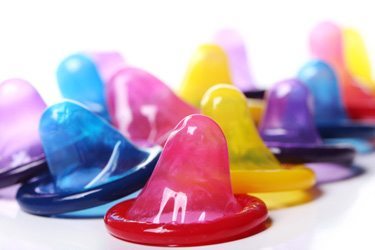This Week in Sex: Celebrating National Condom Week
As National Condom Week (which started on Valentine’s Day, of course) comes to a close, we focus on news about our prophylactic friend.

This Week in Sex is a weekly summary of news and research related to sexual behavior, sexuality education, contraception, STIs, and more.
Many New Yorkers Aren’t Using Condoms
New York City’s health department surveyed 8,500 city residents about their condom use habits and found that less than two-thirds (31.8 percent) of sexually active folks in the Big Apple used a condom the last time they had intercourse. The highest condom use was in central Harlem in Manhattan, where 43.3 percent of sexually active residents used one at last sex; the lowest was in Greenpoint, Brooklyn, where just 14.2 percent did so. The data echo what this annual survey has found since it was first conducted in 2003: Each year, fewer than 35 percent of New Yorkers reported using condoms the last time they had sex.
But before we fret for the health of New Yorkers, the health department explained that in a separate survey of men who have sex with men (who are considered at high risk of HIV), 79 percent of those surveyed in person and 57 percent of those surveyed online said they used a condom the last time they had sex.
Big Apple Residents Can Now Get Bigger Free Condoms
To increase condom use, the New York City health department distributes its own branded condoms. Some of us might remember that during the city’s mayoral election, those free condoms became a campaign issue when Democratic primary candidate Christine Quinn promised supporters that if she was elected they would make sure residents could get better free condoms. At a speech last August, Quinn noted that there had been complaints about the New York City condoms; among the concerns was that the free condoms only came in one size, and that size was too small for some people.
Quinn did not win her party’s nomination, but her wish for residents to get bigger condoms has been realized nonetheless. This week, the health department announced that it will be offering a new, larger condom. Manufactured by LifeStyles, these condoms comes in a gold package and will be called NYC KYNG. Health Commissioner Mary Bassett told the New York Daily News, “We anticipate that New Yorkers will love the new look and appreciate the new size. … These high-quality condoms will help all New Yorkers protect themselves and their partners.”
The department gives away 38 million condoms each year at 3,500 location.
Speaking of Size: A Study to Find the Right Fit
Condoms are stretchy—we know this because many of us have seen a video of a condom being blown up beyond the size of a basketball and still not breaking, which would suggest that they are big enough for any human penis. At the same time, the ring on the bottom can stay tight to keep it in place, which would suggest that they are tight enough for a smaller human penis. Yet, studies have found that the one-size-fits-all approach leaves some men cold.
Last month, the National Institutes of Health (NIH) awarded a grant to TheyFit, which will create custom condoms in 95 sizes. The group will work with Emory University to test the fit of the products as well as a method for men to determine which size will be best for them. (Something slightly more sophisticated than a measuring tape, we’re guessing.) The company will also work with researchers at Emory to “analyze data, previously collected from a national sample of men who have sex with men, to establish condom breakage rates for anal sex. This analysis will provide innovation by allowing further research to move condoms towards being regulated medical devices for anal sex.”
Though some news stories about the grant start by questioning whether the NIH should spend money on penis measuring, the agency notes that the research has relevance to public health: “Condoms are the most efficient and available technology for preventing HIV transmission, but many men don’t use condoms and report problems with poorly fitting condoms … having an expanded range of condom sizes made available is a promising strategy in increasing condom usage, particularly in high-risk populations.”
The Electric Eel, Revealed! (Yes, It’s a Condom)
Two inventors at Georgia Tech, Firaz Peer and Andrew Quitmeyer, think they may have cracked the code of making condoms feel better. Their idea: electrodes that provide a bit of shock to the underside of the penis. They say it feels good, and who are we to argue?
The challenge, however, is getting those electrodes into the inside of a condom as it is being made. The two have yet to solve that riddle, though they have created two prototypes—one by wiring electrodes to an existing unrolled condom and another by using something more like a sock. While they continue to work on wiring latex, they are also working on where to put the power source—which, from the video (below), appears to be nine-volt battery. There current solution is a harness that responds to a man’s breathing.
